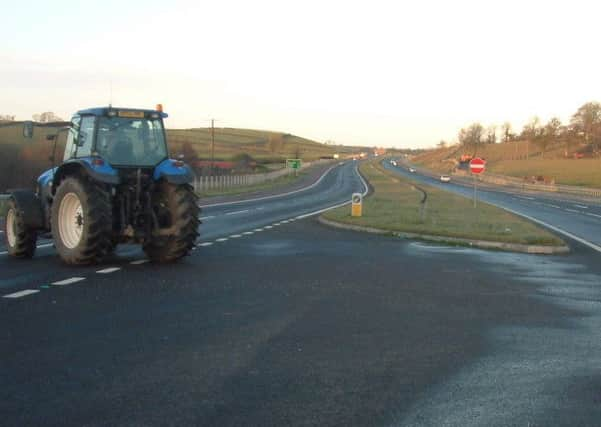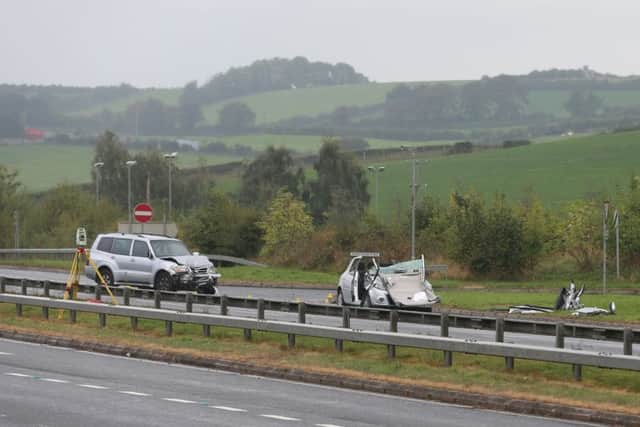Ben Lowry: We must now urgently close the deadly gap junctions on the A1 road


The new dual carriageway ran between Loughbrickland and a place called Beech Hill, north of Newry.
It was a much-needed replacement of a dangerous single carriageway on the route between Belfast and Dublin.
Advertisement
Hide AdAdvertisement
Hide AdThe road had such bad fatality levels that I reported on it often, and kept an informal tally of crash statistics. By my calculations, there were three years when there were seven people killed on the road: 2000-01; 2003-04; 2004-05.


To put that in perspective, around 50 to 60 people die on the roads across all of Northern Ireland in any one year now. Prior to being upgraded, the A1 produced an alarmingly high percentage of the overall NI deaths.
There are far fewer deaths on the route now. That six-mile dual carriageway south of Loughbrickland was part of a process of making the road safer. It removed one of the last single carriageway parts.
Such sections are dangerous on busy roads because cars travelling long distances get frustrated moving at low speed behind lorries and even tractors and undertake the most dangerous manoeuvre on the road, overtaking.
Advertisement
Hide AdAdvertisement
Hide AdOther deadly single carriageways have included the A4 west of Dungannon (on which the Duke of Westminster’s mother was killed in 1987), that was upgraded in 2010, the A6 Moneynick road west of Randalstown to the northwest and the A26 Frosses Road north of Glarryford (which is being upgraded) to the north coast.


All had the same problem and all have been upgraded, or are being, or are due to be.
But there was a problem with the A1 stretch that opened in late 2006. It was built as what is known as an all purpose dual carriageway with so-called “at grade” junctions. To you and me, that means ‘gap’ junctions.
Anyone who has driven almost anywhere on a dual carriageway in Northern Ireland will recognise them. They are breaks in the central reservation through which vehicles turning right on or off the road have to pass.
Advertisement
Hide AdAdvertisement
Hide AdTypically the vehicle has to wait in the middle before finding a space in oncoming traffic through which they can cross through or to the other side of the carriageway.
The junctions are much cheaper than so-called grade separated junctions (ie flyovers). But they are only suited to dual carriageways with low traffic levels, which is why they were often built 40 or 50 years ago.
Now they are so ill-suited to the A1 that they have become the main danger on it. If you drive down the road it seems like darts are coming in from left and right, as vehicles cross the road in front of you often out of a driveway.
The risk is all the greater because the road seamlessly joins a motorway at the southern end, and at its northern end. It has a 70mph limit, as on a motorway, yet all sorts of distractions that are forbidden on a motorway.
Advertisement
Hide AdAdvertisement
Hide AdLong distance motorists who are unfamiliar with the route are one minute on a motorway then suddenly see traffic cut across them.
The danger is present at quiet times too. Among the many people killed at a gap junction was Oliver Ward from Belfast in 2006 when he slammed into the rear of lorry that jutted into the fast lane as it waited a gap in winter darkness.
There are plans to close all the gaps and put a safety barrier down the A1 and build flyovers at intervals along the route. Traffic will have to drive to such a junction before it can turn right. But the 2006 stretch was not included in the upgrade plan.
Why would it be? If you have spent all that money on a new road you are hardly inclined to spend millions more on it a few years later.
Advertisement
Hide AdAdvertisement
Hide AdThe road should never have been built with gaps. Horrified to find that it had been so built, I took the picture that appears at the top of this web page shortly after it opened to illustrate the issues with tractors, etc crossing it.
I wrote a story quoting the AA’s head of road safety, Andrew Howard: “On major inter-city routes, the idea of allowing right hand turns across dual carriageways belongs to the 1960s and 70s. Junction accidents are a major killer on this type of road, and this sort of dated design is asking for such accidents.”
Roads Service responded that the road exceeded standards required for such duals “in the UK Design Manual for Roads and Bridges”.
Even so, it was a bad decision. The first section of the southern M1 opened in the late 1980s. Plans for a complete motorway from Dublin to the border were clear by then, long before the Loughbrickland stretch was built.
Advertisement
Hide AdAdvertisement
Hide AdSadly, there have indeed been deaths. The two nuns killed in 2014 were crossing a gap off the new road.
A dual carriageway with gap junctions is better than a single carriageway so despite the deaths, the road is safer than it was. But we must close all gaps now.
I suggest a 60mph limit on the whole Sprucefield-Newry route enforced with average speed cameras, but on the understanding that it returns to 70mph when complete (keeping the cameras but lifting the limit also past Dromore and Banbridge). The safer, finished road will have a 70mph limit on all of it (but 70 will mean 70, not 80).
There was a death on the A1 eight days ago. It did not happen at a gap junction but off a side road. There are problems with those junctions too, because some side roads are at right angles to the fast road and there is little time for the joining vehicle to build up speed as on a motorway slip road.
Advertisement
Hide AdAdvertisement
Hide AdBut in 2014 it was decided that fewer small side junctions would close than first planned. Politicians seemed more concerned about annoying local users than the needs of the main route.
The A1 should have been a motorway. It would have cost more but the superb southern M1 was partly funded by the toll at Drogheda (which raises almost €200 million a year).
Ben Lowry (@BenLowry2) is News Letter deputy editor